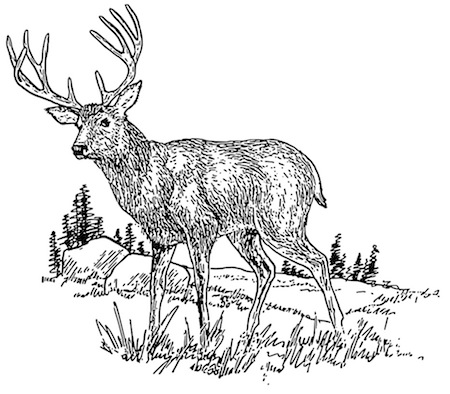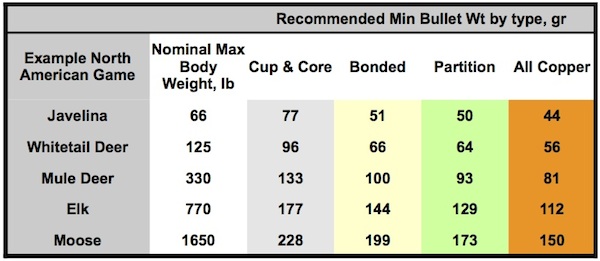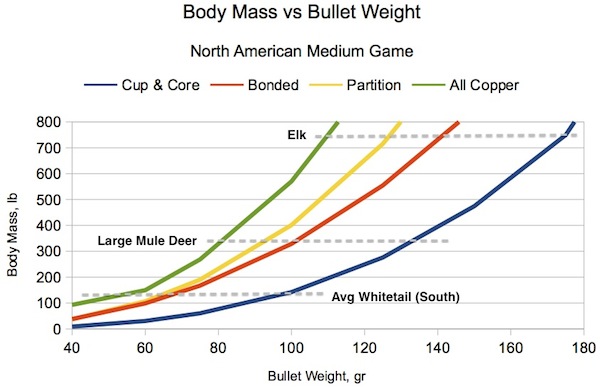| Ideal Weight | Ideal Weight | The Paper | Appendix A | Appendix B | Appendix C | Appendix D |
|---|---|---|---|---|---|---|
| Imperial Units | Metric Units | Defining Ideal Bullet Weight | Math Model | Min. Wound | Depth and Vel. | Depth and Dia. |
Added July 2014: Recommended Bullet Weight Calculator.
We all have heard tales of harvesting deer, elk, and even moose with .22 long rifle ammunition. At the same time, we all know that this diminutive cartridge is nowhere near a satisfactory deer-hunting caliber in the hands of the average shooter. Indeed, this knowledge is codified by hunting regulations that require larger cartridges virtually everywhere where deer hunting is permitted. This collective knowledge tells us that the odds of losing a wounded animal to a long and painful death increase dramatically as one drops below the recommended calibers and bullet weights for a given game species.

Figure 1. Deer. Weights range from about 90 lb (40 kg) for does in the southern US to averages as high as 350 lb (160 kg) or more for bucks in northern states. This broad weight range leads to significant confusion about what deer rifle cartridge is best. Line drawing courtesy of Pearson Scott Foresman (http://openclipart.org/people/papapishu/Deer_2_.svg)
Many of us have an idea of what rifles and bullet weights are best for hunting game like antelope, deer, elk, and hogs with our favorite hunting rifles. For example, the .243 Winchester with its 90-100 gr bullets has built a reputation as a deer harvester but tends to struggle a bit on the larger deer. The .270 and its 130 gr bullets does well on all classes of deer and is marginal for elk, and so on. This understanding is based on a lot of factors including peer advice, reading, and personal experience. Nonetheless, many folks choose bullets and calibers that produce so much recoil that they are challenged to get the bullet to hit within the vital zone of their quarry. Others minimize recoil by choosing small caliber rifles or medium bore guns with lightweight bullets better classified as varmint bullets. Is there a happy in-between in weight and power that can be described as ideal for the intended quarry?
Consider these comments from Bob Stokesi, a Grand Slam Hunter:
“I adhere to the notion that knowledge of the animal’s anatomy, knowledge of how different bullet constructions behave at different impact velocities, and shot placement with this knowledge is more important than using caliber X with bullet weight Y.
I’ve personally taken far more big game with a bow generating only 65 ft lbs of energy, than I have with guns generating a half ton of energy or more. So, I naturally am suspicious of recommendations that say you need a minimum of 1000 ft lbs of energy to insure a clean kill or general CPX 1,2,3,4 types of categorizations. I do however understand that some level of general recommendations are needed to help people make solid choices.”
What general recommendations could we follow in deciding the “Ideal Bullet Weight” for our quarry? Let’s start with this working definition: “The ideal hunting bullet weight is the lightest bullet for our rifle and cartridge that can regularly bring down our intended species within about 10 seconds of being hit in the vital zone.” Why do we suggest the lightest bullet? For the most part, the lightest bullet minimizes both recoil and bullet drop over the most common hunting ranges. These two phenomena have an important impact on our ability to put the bullet into the vital zone. The best weight might tend to creep up as the ranges extend to beyond 250 or 300 yards because wind drift becomes increasingly important as the range increases. Longer and heavier bullets tend to exhibit less wind drift than their lighter counterparts in a given caliber.
Numerous models have been developed over the years to help define bullet weights, velocities, and calibers appropriate for various game animals. Among these models are the ‘Hornady HITS’, the ‘Taylor Knockout Factor (TKO)’, ‘Optimal Game Weight (OGW)’, John Wooters’ ‘Lethality Index’ and the ‘Bekker Knock-Out Value (KOV)’. Go here for brief explanations.
Almost all of the classic models use kinetic energy or momentum in their formulations. Some even appeal to the well-established and scientifically proven notion that sectional density and velocity are critical parameters in determining depth of penetration. A failing common to all of these metrics is neglecting that hunting bullets change shape almost immediately after hitting the animal! The majority of the penetration is accomplished by a ball-like object or a swarm of fragments that do not closely mimic the original bullet shape. This failure in perception generally forces the model developer into one or more awkward hand waving exercises to justify a model that works only some of the time.
We can get closer to a useable metric for the recommended minimum bullet weight by first appealing to hunting knowledge first developed by mesolithic hunters 5,000 to 10,000 years ago. Archeologists have inferred that these hunters learned that their arrowheads needed to be a certain size to bring the animal down close enough to where it was shot that they could routinely recover dinner. “Close enough” was estimated to be 100 yards or so. They did not make the arrowheads larger because we now know that going big did not bring the animal down enough faster to offset the disadvantages of using a larger and heavier arrowhead.
That knowledge can be combined with empirical bullet penetration and expansion data generated by dedicated sportsmen in more recent times to create a model relating bullet weight to animal weight. Bullets weighing more than the recommended weight tend to be rather consistent in bringing the animal down at the cost of increased recoil. The hunter has an increasing failure rate when using bullets that weigh significantly less than the recommended weight even though the generally higher velocity and reduced recoil makes placing an accurate shot easier.
Remember that this in-between is far from an exact statement implying that a bullet weighing a grain or so less than the recommended weight will always fail or one weighing twice the recommended weight is guaranteed to take the quarry. Other factors are very important.
The Challenge

Figure 2. Recommended shot angles for taking medium game.
Our time span of ten seconds means that a properly hit animal is unlikely to travel further than about 100 yards before collapsing. The mechanism causing the collapse is loss of blood pressure which prevents oxygenated blood from getting to the brain and the animal loses consciousness. To be sure, the distance traveled to collapse is frequently less than the 100 yards, but we cannot count on “dropping right there” as a routine event. As an aside, should only veins or arteries not feeding the brain be disrupted, the time to collapse can be much greater, because the animal must lose a lot of blood before we see a significant drop in blood pressure. This longer time to collapse allows more movement, leading to more lost animals.
The vital zone is defined as the area of the thorax containing the heart along with the large veins and arteries converging into it. For deer weighing about 125 pounds (55 kilograms), the zone is about ten inches (25 cm) in diameterii and centered at the top of the heart. The reader may wonder why here and not the brain, neck, or spinal chord or even shoulder joints. The brain is a small target and the animal moves its head frequently and unpredictably, making this shot undesirable unless emergency conditions demand that shot. The portions of the neck where a hit is immediately incapacitating are small in area and hard to visualize. The spinal cord is a small target in the vertical direction, so a small error in aim or range estimate will guarantee a miss and a grievously wounded animal. Hits on the heavy bones of the shoulder frequently don’t cause enough damage to immediately anchor the animal unless rather heavy bullets of stout construction are used so that both the thick muscle and the large bones are penetrated or broken.
Several critical factors influence the odds of ensuring the animal collapses quickly enough that it can be found and recovered:
-
Bullet placement
-
Shot Angle
-
Bullet construction
-
Bullet weight
-
Velocity
-
Ballistic Coefficient
-
Bullet placement – where on the animal the bullet hits – is by far the most important single consideration. There are many reportsiii of medium game being harvested with the .22 rimfire. These shots were by and large taken directly from the side of the animal and placed so the heart or large arteries or large veins just above the heart were pierced. Nonetheless using these small bullets is strongly discouraged because the chances of things not working just right are very high when using them.
-
Shot Angle – Changing the angle so that heavier muscle and bone of the shoulder shields the heart makes many bullets that are otherwise suitable for the game class create superficial wounds that are rarely fatal in the near termiv. Conversely, a quartering away shot frequently means that a significant thickness of internal organs need to be penetrated before getting to the heart area.
-
Bullet construction – Bullet construction and appropriate impact velocity are closely linked. We have all heard tales of folks using varmint bullets launched at incredible velocities on deer. As with the .22 rimfire, this works some of the time, but when the angle or placement isn’t right, we see horrible surface wounds in an animal that escapes to die out of reach of the hunter. At the other end, heavily constructed bullets impacting below their intended reliable opening velocity tend to behave like solid projectiles. We then see very impressive penetration, but the chances of opening enough of the cardiovascular system to get the 10-second incapacitation are low. Shots using either of these extremes work some of the time, but fail often enough that their use should be discouraged. So, one is well-advised to select bullets designed to operate at the velocities to be found over the expected hunting ranges.
-
Bullet weight – Bullet weight and bullet construction together have the greatest impact on the size of the wound channel. Standard bullets made with traditional unbonded lead cores tend to penetrate the least and expand the most while ‘all-copper’ expanding bullets penetrate the deepest and expand the least for a given weight. Bonded and partition style bullets have intermediate performance.
-
Velocity – First, the impact velocity needs to be within the manufacturer’s recommended span of velocities to be sure of reliable expansion. Second, most game is taken at ranges of less than 250 yards and most hunting rifles can be sighted so the bullet stays within the vital zone all the way out to about that range. Increasing muzzle velocity reduces bullet drop, reducing the holdover needed to get the bullet into the vital zone at longer ranges. There is a price to be paid in recoil or using bullets that may be too light for the intended quarry, however. Today, accurate range finding allows the hunter to get precise holdover corrections even for nominally low muzzle velocity rifles out to very long ranges.
-
Ballistic Coefficient – Ballistic coefficient has an increasing effect on wind drift as the range goes over about 250 yards for most hunting cartridges. Inside 250 yards, wind drift is small enough that no correction is needed unless the day is very windy. While increased muzzle velocity helps mitigate drift, heavier bullets with high ballistic coefficients almost always have less drift than lighter high velocity bullets from the same rifle.
Results
These guidelines helped us develop a tool based on an understanding of why mesolithic hunters used arrowheadsv of particular sizes coupled with the behavior of modern hunting bullets in flesh simulating targetsvi,vii. The model and the experimental and historical knowledge underpinning it is described in the appendices. The resulting weights represent approximately the lightest weight bullets one should consider for typical North American medium game. In addition the the chart here, you can also visit the page Recommended Bullet Weight Calculator. This recommended weight calculator lets one calculate bullet weights suggested for your specified animal weights. The calculator is slightly less conservative than the tables and reflects some of the underlying uncertainty.

Table 1. Minimum bullet Weight versus Body Mass of Typical North American Medium Game. Impact velocity must be within manufacturer’s recommended range and the shot must go into the vital zone and within about 30 degrees of the side. Valid for most bullets for impact velocities between 2000 and 3000 fps.
We make two immediate observations from this table. First, the weights apply more or less independently of caliber for most hunting rifles. Second, the statement is independent of velocity as long as the bullet is going fast enough to reliably open and not so fast that it catastrophically fragments. Both of these observations are in strong contrast to other rules of thumb for recommended hunting bullet weights. Nonetheless, the weights fall more or less in line with the lightest bullet in the smallest caliber recommended for the game type.
Another observation that modern “premium” bullets allow us to use lighter bullets than we would if we were using classic bullet designs. Indeed these premium bullets are more effective than the numbers suggest because the lighter weights tend to minimize recoil, making accurate shot placement easier.
Lest one conclude that a 100 grain .308 caliber bullet is the same as a 100 gr .243 bullet, the reader must remember that the light weight .308 caliber bullet is a short and squat bullet compared to the longer aspect ratio enjoyed in the 6mm round. The smaller diameter bullet has better velocity retention and wind bucking characteristics. Further, 100 grain 30 caliber bullets are most frequently designed as varmint bullets with thin jackets and very soft cores.
Through shoulder or quartering away shots require much heavier bullets! The bullet has to go through a a lot of muscle and through bone before it can enter the thorax. Bone is as much as 1.5 times as dense as muscle. That density means that, for straight on penetration, bone is equivalent to about 1.5 times the same absolute thickness of muscle. Add to this the strength of bone, and we open many opportunities for the bullet to be deflected or seriously disrupted. Similarly the rear quadrant shot presents very deep penetration through flesh even if the shooter avoids the hips.
These recommendations do not apply to dangerous game! Animals that have a proclivity for going after the hunter demand much heavier bullets since the shooter frequently cannot wait for a good angle to shoot. Hence the bullet has to go through a lot more stuff to anchor the charging beast. The bullets must also create an adequate wound channel. Deep penetration plus good wound channel diameter means one must use heavy bullets, sometimes solids in larger calibers than would be implied by the weights in the chart above.
The dominant weights of game animals in some regions are sometimes very different from maximum weights used to construct Table 1. If this is true for your region, locate the largest animal you are likely to encounter in Figure 3 and find the suggested minimum bullet weight associated with that size animal.

Figure 3. Minimum bullet Weight versus Body Mass of Typical North American Medium Game. Impact velocity must be within manufacturer’s recommended range and the shot must go into the vital zone. Valid for most bullets for impact velocities between 2000 and 3000 fps. Some regions have animals that weigh much less than the typical maximum weights shown. The plot suggests that smaller bullets could provide adequate anchoring reliability for the lighter animals.
Please refer to the appendices for the math model and supporting data.
ACKNOWLEDGEMENTS: I am grateful to Robert Stokes, a Grand Slam Hunter, for observations of the thickness of deer rib cages as well as suggestions and reminders of exceptions to rules of thumb. Thanks go to Greg Luli for encouragement, good suggestions and an early critical review of the paper and to Gary Sciuchetti for rib cage thickness observations plus anecdotal comments about harvesting deer with smaller than normal cartridges and to Phil Bishop for observations about rib cage thicknesses. I am also thankful for assistance from the staff at the Livermore Public Library for assistance in some of the more challenging research topics.
– – J. A. Smith
# # # #
References:
i Stokes, Robert, Private communication, 6/12/13
ii http://www.chuckhawks.com/kill_zone_game_animals.htm
iii Sciuchetti, Gary, Private communication 5/22/13
iv Stokes, Robert, Private communication 6/11/13
v Friis-Hansen, Jan, “Mesolithic Cutting Arrows: Functional Analysis of Arrows Used in the Hunting of Large Game”, Antiquity, No. 64, 1990, pp. 494 – 504.
vi Sciuchetti, Gary, The Best Hunting Bullet, Handloader, No. 193, pp. 40 – 44, June,1998.
vii http://www.rathcoombe.net/sci-tech/ballistics/wounding.html
Navigation Buttons —
| Ideal Weight | Ideal Weight | The Paper | Appendix A | Appendix B | Appendix C | Appendix D |
|---|---|---|---|---|---|---|
| Imperial Units | Metric Units | Defining Ideal Bullet Weight | Math Model | Min. Wound | Depth and Vel. | Depth and Dia. |

 sending...
sending...